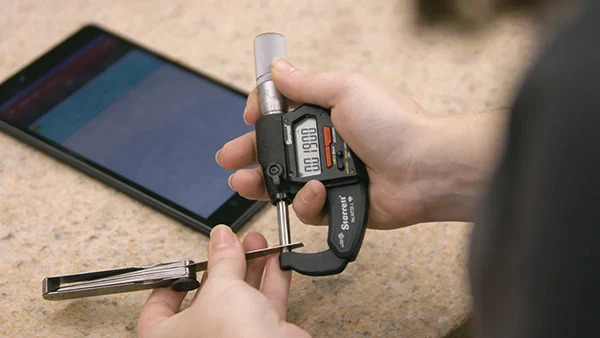There is a wide range of precision measuring tools and gages that should be considered as basic requirements in a metalworking operation for ensuring good quality control (QC) processes. Most gages are available in analog (mechanical readout) or electronic (digital readout with data collecting capabilities), a key requirement for SPC and measurement documentation. Wireless electronic tools are also increasingly an option.
The following is a reference list covering the basic requirements for precision tools:
1. Micrometers: In the hands of a skilled operator, the precision micrometer is the most accurate hand-held tool available. When close measurements to 0.0001″ (0.00254 mm) are necessary, the micrometer is the ideal tool for the job because measurement and reading are on the same axis, and the anvil end is supported by a strong frame. There are many types of micrometers depending on the application—inside, disc, blade—with outside micrometers being most commonly used. Mechanical, electronic and wireless micrometers are available, including electronic models that are IP67 compliant. For use in harsh shop environments where machine coolant, water, oils, dirt, dust and mist are prevalent, measuring tools with IP67-level protection ensure that precision gage accuracy, performance and functionality will remain fully intact when subjected to these elements.
2. Slide calipers are an essential precision measuring tool providing a large measurement range, flexibility and accuracy up to 0.001″ (25.4 μm). These tools typically measure outside, inside, depth and step dimensions. Full-featured electronic tools, with or without IP67 protection and optional output, are available. In addition to common 6″ (152.4 mm), 8″ (203.2 mm) and 12″ (304.8 mm) tools, large, light carbon fiber models are available, as well as more specialized tools with long jaws, alternative contacts and other variations. Dial calipers are very popular; high-accuracy, extended-range Vernier scale tools are another option. Highly specialized applications may warrant a custom-built slide caliper. Wireless models are also available.
3. Height gages are an indispensable instrument for QC, measuring the distance from a reference such as a surface plate to some feature of a part with exceptional accuracy. Generally a scriber, test indicator, touch probe or CMM-style probe is used to locate the measured feature.
4. Depth gages are available in varying forms, complexity, cost and accuracy, from the most accurate depth micrometers (electronic, dial and Vernier) to basic rule gages and combination rule gages.
5. Bore gages are used to check inside diameters of holes, cylinders and pipes. When measuring holes, especially when there are a large number of holes, wireless bore gages can easily collect this data. The technology enables users to measure and collect error-free data to output for Statistical Process Control (SPC) analysis and much more. Also, IP67-compliant models are available.
6. Indicators and gages: There are several major classes of gages, including mechanical dial, electronic display, lever-style test and back plunger. Test indicators and dial indicators, in addition to electronic or wireless indicators, are available. Some electronic calipers are IP67 compliant. Indicator requirements can vary widely, from checking runout to measuring tolerances in go/no-go situations, and they are used in multiple applications. It is best to consult a supplier that offers a broad line as well as an extensive range of accessories to configure and position the gage, and, if needed, supply a custom-engineered indicator solution.
7. Hardness and surface testers: Testing the hardness of a material is critical to determining its ability to resist form change, bending, scratching or abrasion. Hardness testers are available in analog and digital bench solutions as well as compact, portable versions. Shore portable hardness testers are targeted for testing materials such as rubber, soft plastics and leather. Versions are also available for testing hard plastics, such as bowling balls and hard hats. Electronic durometers for measuring Shore A and Shore D values in a wide variety of soft materials are offered. Ultrasonic thickness gages measure the thickness of metallic and non-metallic materials. Coating thickness gages use an integrated probe to automatically determine whether the substrate is ferrous or non-ferrous, and then either detect the thickness of non-magnetic coating on a magnetic substrate (ferrous) or the insulating coating on a non-magnetic conductive substrate (non-ferrous). Testing surface roughness is important to determine if a surface is suitable for a particular purpose.





